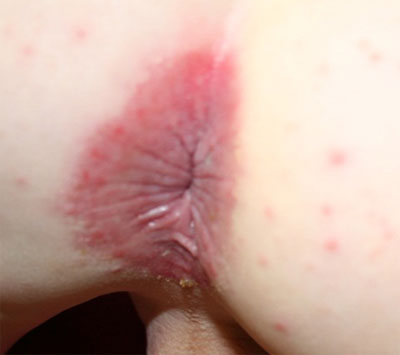This photo demonstrates a finding observed on a 3-year-old boy with perianal itching and pain. He has had a few blood-streaked stools. His mother has been applying nystatin cream to the area, but it continues be inflamed and sharply demarcated. She denies any history of sexual abuse or trauma to his rectal area.

Source: A. S. Botash, MD, used with permission
Accessible Version
A photo of the anus of a male child in the knee-chest position with erythema and induration surrounding the anus.
Which of the following statements is most likely?
◯
A. This is a case of resistant Candida.
◯
B. The redness is likely from chronic abuse and a hotline report should be made.
◯
C. Thayer Martin is the most appropriate culture media for a diagnosis.
◯
D. A throat culture will likely reveal the same organism as a culture of the perianal area.
◯
E. C and D.
Which of the following statements is most likely?
◯
A. This is a case of resistant Candida.
◯
B. The redness is likely from chronic abuse and a hotline report should be made.
◯
C. Thayer Martin is the most appropriate culture media for a diagnosis.
✓
D. A throat culture will likely reveal the same organism as a culture of the perianal area.
◯
E. C and D.
The best answer is D
The photograph demonstrates an area of erythema and induration commonly seen with perianal Group A beta hemolytic streptococcal (GABHS) cellulitis or dermatitis. Because this infection can occur anywhere in the perineum, it has also been called perineal streptococcal cellulitis. The infection commonly occurs in children aged 6 months to 10 years, and boys are affected more commonly than girls. Painful defecation or blood-streaked stools may occur.
Over 90% of children with this disease have concomitant positive streptococcal pharyngeal cultures. However, these patients usually do not have pharyngeal or systemic symptoms. Fever, scarlet fever rash and subsequent desquamation are rare with perianal streptococcal disease. Flares of guttate psoriasis have been observed by some, and for this reason, some recommend swabbing the perianal area for strep cultures in cases of guttate psoriasis. Follow-up urinalysis is recommended due to the potential for the rare occurrence of post-strep glomerulonephritis that was reported following a case of vaginal strep. Symptoms may rarely be caused by Group B or G beta hemolytic streptococcus or by Staphylococcus aureus.
The condition can be diagnosed by a rapid strep test or plating a swabbed specimen onto blood agar, not Thayer Martin media. Thayer Martin media is used for the detection of Neisseria species, including N. gonorrhoeae. Although gonorrhea may present as a perianal infection, anorectal infection is generally asymptomatic with no anal symptoms.
This disease is commonly misdiagnosed as Candida dermatitis and may be misdiagnosed as a finding from trauma or sexual abuse. Lack of satellite lesions, presence of a mucoid discharge and lack of response to treatment with antifungals should alert the provider to the true diagnosis. Without a history of trauma, infection is a more likely diagnosis. Pinworms generally do not cause such significant redness.
Treatment with penicillin or penicillin-derivative antibiotics is recommended, similar to the dosing for pharyngeal infection, but with prolonged treatment (14 days by some authors, 21 days recommended by others). Penicillin-allergic patients may receive erythromycin or topical mupirocin. However, recurrence of the infection is common and repeat culture in follow up after treatment is recommended. Some physicians recommend swabbing and testing asymptomatic siblings.
- Herbst RA. Perineal streptococcal dermatitis/disease: Recognition and management. American Journal of Clinical Dermatology. 2003; 4 (8) : 555-560.Perianal streptococcal dermatitis (PSD) is a pediatric dermatologic infectious disease predominantly affecting children, particularly younger children, which is most commonly caused by group A $\beta$-hemolytic streptococci (GABHS). Although the clinical picture of a sharply demarcated erythema is very characteristic, PSD is often misdiagnosed for long periods of time and patients are subjected to treatments for a variety of differential diagnoses. Vulvar and penile involvement with similar signs and symptoms have been documented in several patients with PSD. The diagnosis is made by either a swab of the affected region submitted for microbiological analysis with the specific question for GABHS, or a rapid strep test. Systemic antibiotics such as penicillin, erythromycin, newer macrolides, or others, probably augmented by topical antiseptic or antibiotic ointments are the treatment of choice. Treatment duration should be at least 14 days or, even better, 21 days, and be dictated by clinical and microbiological cure. Therefore treatment success should be investigated not only by clinical examination but also by post-treatment perineal swabs as well as a urine analysis to monitor for post-streptococcal glomerulonephritis. The author of this review supports the recent suggestion to summarize GABHS-induced vulvovaginal and penile infections together with PSD under the inclusive term 'perineal streptococcal disease' because these conditions coincide, share important clinical characteristics and, therefore, represent manifestations of the same disease.



